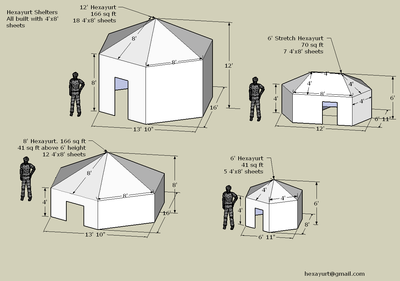Hexayurt

The hexayurt is a simplified disaster relief shelter design. It is based on a geodesic geometry adapted to construction from standard 4×8 foot sheets of factory made construction material. It resembles a panel yurt, hence the name.
History
The hexayurt project has been running since 2003. It was featured in Design Like You Give a Damn (Metropolis, 2006), a book on shelters produced by Architecture for Humanity. In August 2007, the project won the Participate award, which is run by TreeHugger, Current.TV and the Burning Man festival.[1]
Design

The hexayurt was designed to be constructed out of 4×8 foot sheet materials. This building's design is in the Buckminster Fuller lineage of using contiguous triangles to maximize the load-bearing ability of simple structures. The basic construction principle is to use full sheets for the walls. Sheets cut from one corner to the opposite corner provide right triangles. Each pair of right triangles can be assembled into an isosceles triangle that is 8 feet wide and 8 feet in height, thus forming a roof panel. For constructions made from light material the panels can be joined by tape. For heavier builds made out of OSB or plywood, metal brackets or wooden blocks can be used. The instructions are available on Appropedia (Appropedia is used as the wiki for the hexayurt project) and are released as public domain by the inventor Vinay Gupta.
For hexayurts fabricated from four-by-eight foot sheets of foam or hexacomb cardboard and duct tape, the cost has been estimated at $1,000 each. Hexayurts fabricated from OSB and wooden blocks can cost as little as $250–300.
Plans are being developed to equip them with high-efficiency wood stoves, composting toilets and fluorescent lights.[3]
Although construction is easy, plastic foam panels contain too much open space to fit many efficiently in a shipping container. The designer plans to use the expanding cardboard panels to solve that problem.
The model that sees frequent use at the Burning man festival is 166 square feet (15.4 m2) in size and uses 12–18 sheets of foil-covered polyisocyanurate insulation, or hexacomb cardboard. Buildings are held together with half-foot-wide bi-directional filament tape and then covered with foil tape for safety and anchored to the ground like tents. A plastic tarp provides a floor. Tape is used to make simple hinges on doors and windows. Window covers are hinged at the top to form window shades.
Hexayurt infrastructure package
The project makes suggestions for infrastructure:
- Use solar recharging of AA-size batteries to provide power for the stove, LED flashlights, and portable radios.
- Provide water via solar water disinfection.
- A portable composting toilet sanitizes human waste.
- The designer utilized a commercially-available inflatable satellite antenna for telecommunications.
Networked Domestic Disaster Response
The hexayurt is integral to the Networked Domestic Disaster Response project, which focuses on public coordination of disaster relief efforts, offloading the responsibility largely from the state or government, which unites several cheap and readily available technologies to perform tasks that have been historically left to highly trained teams with expensive apparatus.
The plan outlines a system of cellphone-accessible databases which would collocate raw materials, displaced people, host families and volunteer building teams to rapidly provide temporary accommodations for people made homeless by a natural disaster or man-made circumstances. The plan has been positively reviewed by the American Red Cross and the Federal Emergency Management Agency.
The key feature to the use of hexayurts in the plan is that materials used for hexayurt construction are widely used in the American building industry. According to Pima, 4 billion board feet of polyisocyanurate insulation boards are used annually, which is enough to shelter 600,000 people if one day's worth of boards were converted into hexayurts. However, polyisocyanurate is less used in building industry outside North America.
See also
References
- ↑ Participate! Winner: Vinay Gupta's Hexayurt, TreeHugger, August 15, 2007.
- 1 2 http://www.tilings.org.uk/Hexayurt_Family.pdf triangle roof panel made from a 4x8 sheet, Quad-dome variation by Edmund Harriss
- ↑ This Is Only a Drill: In California, Testing Technology in a Disaster Response, John Markoff, New York Times, August 28, 2006
External links
- Hexayurt.com - official website.
- Can we build a world with open source?, Victor Keegan, The Guardian, Thursday 5 March 2009.
- Article at MAKE
- Appropedia on the Hexayurt
- Networked Domestic Disaster Response website
- The Hexayurt: Efficient Emergency Shelter TreeHugger, March 18, 2007.
- This article contains content from the Appropedia article Hexayurt Project, licensed under Creative Commons under the Creative Commons Attribution-Share Alike 3.0 (unported) License.
